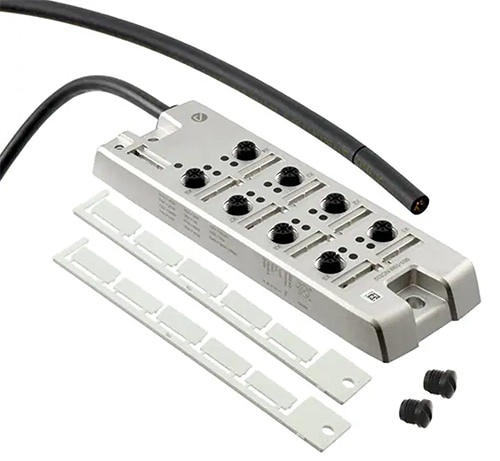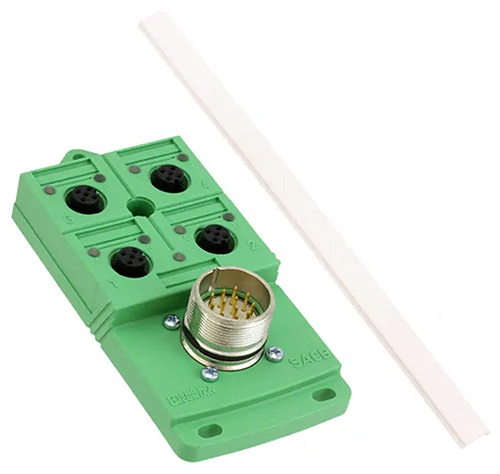Configure Industrial Sensors and Actuators Faster, Safely, and Reliably with Sensor Actuator Boxes
Contributed By DigiKey's North American Editors
2021-06-08
Designers of modern industrial automation (IA) equipment can appreciate how quickly they can expand to stretch across hundreds of square feet inside a facility. Running separate cables between the control computer and any proximity sensors and mechanical arms in the process area can clutter the facility floor and slow the time it takes to configure that equipment. In addition, replacing or reconfiguring an existing sensor or actuator can require running another cable between the process location and the control computer, slowing maintenance. The problem only expands with the push to connect more systems to the Internet of Things (IoT) to track them on a remote dashboard via the cloud.
To simplify these connectivity problems, designers of industrial systems can use sensor actuator boxes (also called junction boxes and distribution boxes). Using these devices, many sensors and actuators can be connected by running one master line from the control computer to a box that terminates in many connectors at the process location, simplifying floor wiring.
This article will briefly discuss the issues associated with IA connectivity. It will then introduce three real-world sensor actuator box examples—one each from Molex, Alpha Wire, and Phoenix Contact—and show how they can simplify wiring in an industrial environment while easing maintenance and configuration.
Connecting control computers to sensors and actuators
Many control computers in industrial automation environments are conveniently located near the equipment they are controlling. Cables from the computer to the sensors and actuators can be relatively short, often about one or two meters. However, in some industrial facilities, control computers can be located many feet away, requiring multiple cables to be run between the two locations. This is common in assembly plant robots, conveyor belt facilities, and also large industrial vehicles such as trucks and aircraft. In some situations, the process area can be hazardous, with the location exposed to harmful chemicals or temperature extremes. For this type of machinery, the control computer is often placed at a safe, protected distance to maximize reliability.
Conventional wiring in such situations would involve sending multiple cables from the control computer to each sensor and actuator. This is not always a straightforward operation. The proper cable termination connectors must be used at each end of the sensor or actuator cable. In many hazardous environments, it can take more time than expected to ensure that the cable is safely and correctly routed. Finally, the time it takes to configure and connect the cabling for each sensor and actuator slows the deployment operation and adds cost. If the facility needs to be shut down to replace or configure more than one sensor or actuator, this will add to downtime, further increasing costs, sometimes dramatically, depending on the facility.
Sensor actuator boxes
A safe and cost-effective solution is for an IA facility to use sensor actuator boxes. These boxes group all the sensor and actuator cables from the control computer into a single master cable, often called a home run cable, which runs to the process area. The cable terminates near the process area in a single rugged connector box that contains connector receptacles, usually eight or more M12 connectors. Sensor actuator boxes are also sometimes called junction boxes, distribution boxes, and also IO or I/O boxes. The connector box with the mounted M12 receptacles is a sealed, prewired unit rated IP67 or better.
The home run cable for all the sensors and actuators needs to be routed and placed only once. This is an advantage when routing the cable in confined areas, as technicians do not need to spend additional time-twisting themselves into and around cramped spaces.
With a sensor actuator box, instead of connecting equipment by running a long cable between the control computer and the process area for each sensor and actuator, a technician connects one end of a shortened cable to the nearby sensor actuator box and the other end to the equipment. This can be as fast as a matter of seconds, minimizing the time spent by the installer in the process area. This simplifies maintenance and improves safety while saving time and reducing errors.
Choosing and using sensor actuator boxes
Sensor actuator boxes come in a variety of designs, but some factors to consider include visibility, ruggedness, the type of material, weight, form factor, the number of receptacles, current-handling capability, mounting options, and IP ratings for dust, moisture, and gas ingress, just to mention a few.
For example, in particularly rugged environments, such as industrial trucks and warehouses where equipment can be subject to heavy impacts, Molex has the Brad Safety multi-port interconnection system (MPIS) distribution box family. These heavy-duty boxes are made of polybutylene terephthalate (PBT) which is both lightweight and strong and able to handle high impacts from heavy equipment or even an impact from a moving vehicle.
Picking from the line, the Molex 1202480510 MPIS 8-port distribution box supports up to 4 amperes (A) per port, with a maximum 12 A for all eight ports combined (Figure 1). To aid during interconnect, each port has a recessed area for a snap-in label made of acrylonitrile butadiene styrene (ABS) plastic. These labels are more robust and don’t tear compared to paper labels.
 Figure 1: The Molex 1202480510 MPIS is a sensor actuator box with eight M12 receptacles. For ease of interconnect, each port supports a snap-in label made of rugged ABS plastic. (Image source: Molex)
Figure 1: The Molex 1202480510 MPIS is a sensor actuator box with eight M12 receptacles. For ease of interconnect, each port supports a snap-in label made of rugged ABS plastic. (Image source: Molex)
The Molex 1202480510 is bright orange for ease of visibility and is rated IP67, making it suitable for use in dirty, dusty, and damp environments, and across temperatures ranging from -25°C to +85°C typical. The home run cable is 5 meters (m) long and supports a custom cable termination that is typically an M23 connector but can be any connector needed for the application. Each recessed M12 receptacle has eight pins in an industry standard configuration. Each port has an amber LED to indicate that a port is powered. This helps to quickly verify that a port is active, which is useful during configuration and when diagnosing connection issues.
The Molex sensor actuator box has two slot holes for M4 mounting screws. This allows the box to be mounted on equipment or solidly to a wall. The box should be mounted where the eight M12 receptacles are easy to access and should be secure enough so that the force of pushing an M12 connector into its receptacle does not displace it.
Lightweight sensor actuator box applications
For applications where weight is a concern, such as an aircraft or some industrial vehicles, Alpha Wire offers the Alpha Connect family of passive distribution boxes, including the Alpha Connect 901-10M NC032 8-port sensor actuator box (Figure 2). This Alpha Connect box is made of lightweight zinc alloy which is suitable for aircraft, small trucks, and battery-powered vehicles such as forklifts and small earth movers where every ounce counts. It has a 10 m home run cable, which is appropriate for aircraft and vehicles where the shortest distance between two points is often not a straight line but a twisting passage. The box is passive and does not have port indicator LEDs. Its neutral beige color allows it to blend inconspicuously into many environments.
The unit includes two dust covers to keep any two unused receptacles clean from contaminants. The sensor actuator box with mated connectors is rated IP67. Unmated receptacles are rated at IP65 and so should have the dust covers installed to ensure IP67 protection.
 Figure 2: The Alpha Wire 901-10M NC032 sensor actuator box is made of lightweight zinc alloy. The eight M12 receptacles project above the housing so connector mating is quick and easy. Two included dust covers in the right foreground keep unused receptacles clean. (Image source: Alpha Wire)
Figure 2: The Alpha Wire 901-10M NC032 sensor actuator box is made of lightweight zinc alloy. The eight M12 receptacles project above the housing so connector mating is quick and easy. Two included dust covers in the right foreground keep unused receptacles clean. (Image source: Alpha Wire)
Each M12 receptacle has five pins. For ease of installation during initial setup, the standard M12 cable color code and functions for each pin are printed on the side of the sensor actuator box. The eight M12 receptacles are not recessed but instead project above the zinc alloy housing. This enables a fast and easy connection, which is important in a busy industrial environment.
The Alpha Wire 901-10M NC032 sensor actuator box is rated for -40°C to +80°C, making it appropriate for very cold industrial environments, which both aircraft and some vehicles encounter.
Compact sensor actuator box
For small, space-constrained applications, Phoenix Contact designed the 1692404 4-port sensor actuator box (Figure 3). This box does not have a home run cable and requires a separate M23 cable assembly to connect to the control computer, allowing the box to be easily relocated. It also allows for easy maintenance and replacement of the home run cable if it is damaged.
 Figure 3: The Phoenix Contact 1692404 sensor actuator box has four 4-pin M12 ports. It requires an external M23 cable assembly to connect it to the control computer. (Image source: Phoenix Contact)
Figure 3: The Phoenix Contact 1692404 sensor actuator box has four 4-pin M12 ports. It requires an external M23 cable assembly to connect it to the control computer. (Image source: Phoenix Contact)
The 1692404 is made of polyamide, which has a high resistance to gasoline, motor oils, and solvents normally found near engines. Polyamide also has extremely high tensile strength and can handle non-impact stress and bending better than most materials. The unit is IP67 rated and has an operating temperature of –20°C to +75°C, making it appropriate for rough handling in warehouses, office buildings, and areas commonly occupied by personnel working near chemicals.
Each of the four M12 connectors can handle up to 4 A, with a total maximum rated current draw for the unit of 12 A. Each of the four M12 ports has a yellow LED to indicate when the port is properly mated and operating. The M23 port has a green LED to indicate that the home run cable is properly mated and powering the box. This is useful for diagnostics during setup and configuration. All the sensors and actuators connected to the four M12 receptacles can be easily disconnected by removing the single M23 connector. This enhances safety and reduces downtime during maintenance and reconfiguration.
Conclusion
Sensor actuator boxes can save time during maintenance and setup, while ensuring reliable connectivity between control computers and sensors/actuators. Many sensors and actuators can be easily connected locally at the process area instead of running all the cables individually to the control computer. Proper selection of materials ensures that the box will operate reliably in the target industrial environment.

Disclaimer: The opinions, beliefs, and viewpoints expressed by the various authors and/or forum participants on this website do not necessarily reflect the opinions, beliefs, and viewpoints of DigiKey or official policies of DigiKey.








